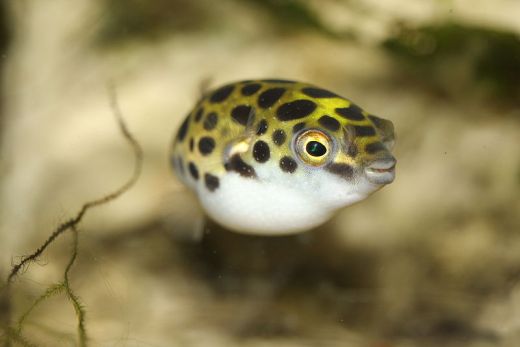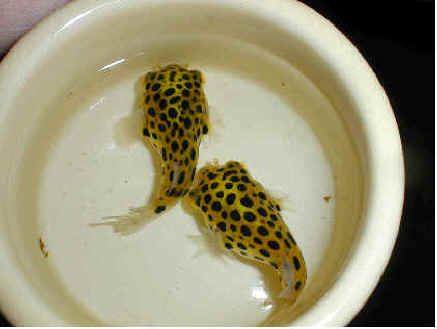If you’ve ever decided to look further into green spotted puffers (GSPs) than just noticing them at your LFS, you’ve probably run into a large variety of conflicting opinions and professional recommendations alike. I, unfortunately, am not here to declare definitive stances on anything, but rather to share what I have learned in my own experiences owning one, then two GSPs over the last two years.
Firstly, GSPs sometimes get mislabeled in fish stores. True GSPs, Tetraodon nigroviridis, when healthy have the following appearance traits:
- bright white bellies
- a neon yellowish lime colored top half that gets reflective and brighter on top of their “head”
- dark black, round spots all over their greenish portions, with some overlapping near the boundary to their white portions
- Puffers often change color to match their surroundings, and some just seem to change color. I’ve never seen anything this drastic in my puffers, but this person’s puffer has the ability to alter its coloration dramatically.
- They’re not going to be puffed up like a giant round ball unless under extreme stress. Without having to be a huge, spiky ball, puffers are still pretty round fish
- Two eyes on either side of their head that can move independently to look around. These stick out of their heads a bit, and you can see the motion of their individual eyes changing their lines of sight.
- Teeth. These little puppies got teeth. This impacts their diet, because their teeth don’t stop growing.
- Two small side fins and a tail – all a translucent pale green.
Puffers are really curious and endearing. For all their known aggression with other fish, they have many ridiculously comical traits that make them seem harmless and endearing. Puffers often “blimp” around, pretty much hovering in place with fluttering side fins that look too small for their large bodies. Sometimes they’ll just stay exactly in place while slowly curling their tail toward their side, causing them to spin in a perfect little circle. Then they’ll see a snail across the tank. One sudden sprint later, they’re biting through the shell and sucking out the inhabitant in one swift moment. Then they’ll watch you watching them from the other side of the glass, deciding whether to come toward you to get more food or to wait cautiously for you to move first. Some puffers are attention hogs who will swim to the glass immediately to meet you, while others are cautious and easily spooked. But all of them seem to be really adorable.
Though most people tend to be drawn to GSPs when they see them and think that they are quite cute, GSPs are not common pets because of their high difficulty of care and stringent tank requirements. You pretty much seem to need GSPs in their own tank, else have thirty or so gallons of water per GSP. This is a lot of aquarium space for a single fish to need. Furthermore, they need good quality water to actually be healthy and grow. Yet this is difficult to maintain with a GSP because of their enormous bioload and inability to utilize plant growth for filtration given their changing salinity levels throughout development. So, you’ll need to make sure you have the tank over-filtered with good flow throughout the tank. Regular water changes and substrate vacuuming will be especially important – meaning GSPs are high maintenance fish. Oh, then there’s their absolutely required special diet. Since these protein lovers don’t really chew on anything unless they’re eating, you need to feed them hard foods (snails, crayfish, clams) that will wear down their teeth. And when you’re not feeding them that, most won’t take anything less than frozen bloodworms, freeze dried krill, defrosted or live shrimp, or other such ‘meaty’ foods.
Before you take a GSP home, do your research on these fish. While they can be rewarding creatures to care for, they have lots of quirks that commonly sold freshwater fish do not. Go read through many different websites about GSPs to hear many opinions. Learn to interpret your GSP’s individual signs of stress and aim to find what seems to make your GSP as calm, curious, and brightly colored as you can get them. Some of the websites I visited and still visit at times when I have a question or concern are thepufferforum.com, myfishtank.net, this hubpages.com site, or other such sites I find from googling various names for the GSP (like GSP, Tetraodon nigroviridis, green spotted,…) and terms about the questions (like teeth, pale, help,…). For more general, beginner info, sites like fishbase.org’s pageor seriouslyfish.com’s page would be decent starting sites. If you want me to add a suggestion, let me know or put it in the comments for me to add.
Here is my GSP Jake:
Normally, two GSPs in a 20 gallon is a bad idea, but my first, Jake, was an extremely shy fish. After eight months of researching and incorporating attributes of successful GSP habitats and tanks, Jake was still extremely shy, easily frightened, and rarely seen. He would occasionally get spooked by a ghost shrimp that snuck up on him. Jake was so passive that the ghost shrimp began breeding and multiplying in the tank with him. Yet his appetite an coloring were great. I tried adding more hiding spaces, breaking more lines of sight, adding more swimming room at various water levels, changing substrate, adding more filtration, adjusting water flow/turbidity, adjusting pH (they like higher pH than average), adjusting the lighting, changing diet,… I finally decided that another GSP would be my best bet. This would also let me see if Jake’s behavior was exhibited by a second GSP. If two GSPs both had Jake’s irregularly shy and skittish behavior, then the tank setup would have remained a probable cause. Thus came Finn:
So to Jake’s tank, I added Finn. Finn originally followed Jake everywhere in the tank, with Jake mostly running away. I almost brought Finn back that first day because images of Jake suddenly going all Ozzy Osborne on Finn’s fat little face if he got too fed up with it. Within an hour or two, Jake and Finn had settled and were napping a few inches away from each other peacefully. Jake has become much more active and social, and the two seem to get along wonderfully. They are both still less than half their likely final size, and I don’t expect Jake and Finn to live happily ever after together in a 30 gallon tank. Within the next year or so, I plan on either upgrading them to a larger tank, or, more likely, only keeping one and moving them to a 33 gallon (or larger) long, rimless tank.
I plan on doing a post in the near future on creating a beautiful tank without using live plants. Since GSPs need a higher salinity than most freshwater plants tolerate yet a lower salinity than marine plants can tolerate, GSP tanks are very difficult to plant. Maybe once I have figured out freshwater better I’ll give it a go, or wait until they are mature enough to do a full marine planted tank, i.e no corals. In many ways, the GSP tank has been harder for me to decorate as I would like, so it has gone through many different iterations and changes. I have some decent pictures of at least four different GSP setups that will be the subject of a future post.











